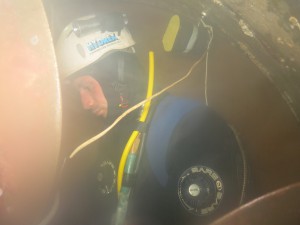Keeping dry when the outlook is wet
 The introduction of advanced underwater repair techniques and equipment now means that entire thruster units can be removed, overhauled or propeller blades and seals replaced or repaired while the vessel remains afloat, minimising the impact on operational schedules and budgets. Hydrex Underwater Technologies, last year unveiled its next generation flexible Mobdock system to meet the demands of shipowners looking to reduce time spent drydock.
The introduction of advanced underwater repair techniques and equipment now means that entire thruster units can be removed, overhauled or propeller blades and seals replaced or repaired while the vessel remains afloat, minimising the impact on operational schedules and budgets. Hydrex Underwater Technologies, last year unveiled its next generation flexible Mobdock system to meet the demands of shipowners looking to reduce time spent drydock.
“Our lightweight Mobdocks can be transported to any location around the world, to facilitate thruster repairs during a vessel’s port stay,” says Dave Bleyenberg, Production Executive at Hydrex. “The size of the thruster unit doesn’t matter or the type of ship, since the Mobdock design can be tailored to meet the requirements of each specific project. Although bow thrusters can be removed quickly and ‘in the wet’, reinstallation does need to be done in a dry environment because the blades need to be replaced without water ingress.”
Bleyenberg says that in the past thruster overhauls were planned to coincide with a scheduled drydocking, resulting in extended off-hire time and drydock fees as the vessel would invariably wait for the overhauled thruster to return for reinstallation.
“We can reduce these costs by simply removing the unit while the ship is afloat and have it overhauled by the Original Equipment Manufacturer (OEM) so it is ready when the vessel enters drydock. This really speeds up the repair process. We can also reverse the procedure so that if a thruster is removed in drydock, we can reinstall it under water in dry conditions at a later date. In this way, the ship can already leave drydock while the unit is still with the manufacturer.”
Recently, diver-technicians removed the bow thruster of a large offshore supply vessel and reinstalled the unit after it was overhauled. By carrying out both parts of the operation underwater while the vessel was at anchorage in Dampier, Australia, the ship could stay on project as there was no need to enter dry dock. “After the bow thruster was removed it was overhauled locally by the OEM. Our team remained on stand-by so that it could start the dry reinstallation when the bow thruster arrived back on location,” recalls Bleyenberg.
“Last year we performed underwater thruster repairs on two vessels for the same owner simultaneously. Repairs were carried out on both azimuth thrusters of an FPSO while the thruster seals of a heavy load carrier were replaced, helping to expedite the repair and keep costs to a minimum. The stern thruster tunnel of the heavy load carrier was sealed off with Mobdocks. Water was then emptied from the thruster tunnel, creating a dry workspace around the unit to carry out a full inspection. Four blade and three shaft seals needed replacing.”
Meanwhile, a special cofferdam was designed to repair the oil distribution box on the FPSO’s thruster unit. This enabled the team to carry out the repair without removing the thruster. The vessel’s other azimuth thruster had more serious problems and a complete removal was required but as the thruster was not designed to be removed underwater, a bespoke procedure was created to remove the unit.






